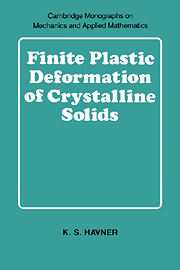Book contents
- Frontmatter
- Contents
- Preface
- 1 An Historical Introduction
- 2 The Kinematics of Double Slip
- 3 A General Theory of Elastoplastic Crystals
- 4 Axial-Load Experiments and Latent Hardening in Single Crystals
- 5 Analysis of Crystals in Channel Die Compression
- 6 Theoretical Connections between Crystal and Aggregate Behavior
- 7 Approximate Polycrystal Models
- Appendix: The General Theory of Work-Conjugate Stress and Strain
- References
- Index
6 - Theoretical Connections between Crystal and Aggregate Behavior
Published online by Cambridge University Press: 11 September 2009
- Frontmatter
- Contents
- Preface
- 1 An Historical Introduction
- 2 The Kinematics of Double Slip
- 3 A General Theory of Elastoplastic Crystals
- 4 Axial-Load Experiments and Latent Hardening in Single Crystals
- 5 Analysis of Crystals in Channel Die Compression
- 6 Theoretical Connections between Crystal and Aggregate Behavior
- 7 Approximate Polycrystal Models
- Appendix: The General Theory of Work-Conjugate Stress and Strain
- References
- Index
Summary
In this chapter we return to the general theoretical framework of Chapter 3 and extend it to the analysis of characteristics of overall response of macroscopically uniform polycrystalline solids. The objective is the presentation of a rigorous theoretical connection between single-crystal elastoplasticity and macroscopic crystalline aggregate behavior. The development is based upon the original analysis of Hill (1972) and other basic contributions in Hill & Rice (1973), Havner (1974, 1982a, 1986), and Hill (1984, 1985). Central to an understanding of the crystal-to-aggregate transition is the well-known “averaging theorem” introduced by Bishop & Hill (1951a) but only given its final form and initial proof at finite strain in Hill's (1972) seminal work.
Crystalline Aggregate Model: The Averaging Theorem
At the beginning of Chapter 3, the scale of a crystal material point in a continuum model was defined to have linear dimension of order 10−3 mm: greater than 103 lattice spacings but at least an order of magnitude smaller than normal grain sizes in polycrystalline metals. Consider now the choice of physical size of a representative “macroelement” that defines a continuum point at the level of ordinary stress and strain analysis (that is, in structural and mechanical components or materials-forming operations.)
The wall thickness of thin-walled metal tubes used in combined stress tests (say, axial loading and torsion) often is in the range 1−2 mm and 10 to 30 grains (see, for example, Mair & Pugh (1964) or Ronay (1968)).
- Type
- Chapter
- Information
- Finite Plastic Deformation of Crystalline Solids , pp. 164 - 181Publisher: Cambridge University PressPrint publication year: 1992
- 1
- Cited by



